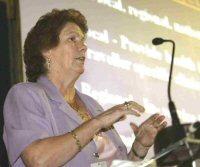A day in the life of a Traveller woman

Travellers are only now reaching the life expectancy that settled people achieved in the 1940s. Missie Collins, of Pavee Point, writes about two critical areas of concern for her community – the conditions in which Travellers live and their health status
Traveller families are living on the side of the road. There are nearly 1000 families out there now, with no running water, no electricity, and no toilets. Can you imagine how hard this is? Especially for the Traveller mother with children; just a basin of cold water to wash them – it is very hard. More often than not there may be only one tap supplying 40 families with cold water, and often the tap is broken.
By "living on the side of the road" I mean that it could be anywhere, in the middle of nowhere. When they build sites, they put them near dumps, near railways and behind banks of earth – places where noone else will live. Travellers do their best to keep these sites, but they need to be more involved in the planning process and decisions as to where they are placed. Travellers do not have a choice where they live.
The vast majority (90 per cent) of Travellers cannot read or write. We want to encourage our children to go to school – and not just to primary school. There is only a handful of Traveller children going on to secondary and higher education. They need to be given more support and encouragement because it is vital.
Discrimination is part of every day of the week with us. Going round the supermarket, we are followed around the shop. Can you imagine how we feel? How depressed that makes us feel? It is everyday life on our plate, no matter where we go. Some people say it to our face and others do it behind our backs.
When I first started at Pavee Point, on an ordinary development course along with 15 other women, we had no confidence in ourselves. We had not many skills; most of us could not sign our own name. When we found out about our own bodies, and we realised how many of our young women were dying – and did die – in childbirth, because of a lack of information, we knew we had to try and do something. We decided to report to the health board to see if we could get primary health care up and running for Travellers. One of the things we do is education material; we make videos on children and on women's health. These projects do work, and the proof of the pudding is in the eating. Now 35 more projects around Ireland are providing primary healthcare.
We campaign at different levels; a higher level, a medium level and a lower level. I was involved in a committee within the Department of Health, with two more Travelling women and some staff from Pavee Point, along with people from the Department of Health and other various places. We were seven years campaigning for a health strategy for Travellers. But at last, in the year 2002, we got our health strategy.
It is also important to see our young children in school. Children should be taught more about Traveller culture, even at a very young age, because Travellers have their own culture; they have their own beliefs and their own ways.
We need more policies, we need more speakers. We need more support from every society in the world today to help Travellers to fight for their rights and all that they are up against. Unless that is done they will be kept down all the time. I would like to see the scales balanced. I suppose it is going to take time. I would like to see the scales level, so that justice will be done for us all.
This is an extract from a new report 'Creating Connections. Health inequalities on the island of Ireland' published by the Public Health Alliance Ireland on 24 January.
Other contributors include Mary Robinson on global inequality and health, Ron Labonte on advocating for health, Charles Secrett on political mobilisation and Sir Donald Acheson on the inequality challenge.
? More: www.publichealthalliance.org
